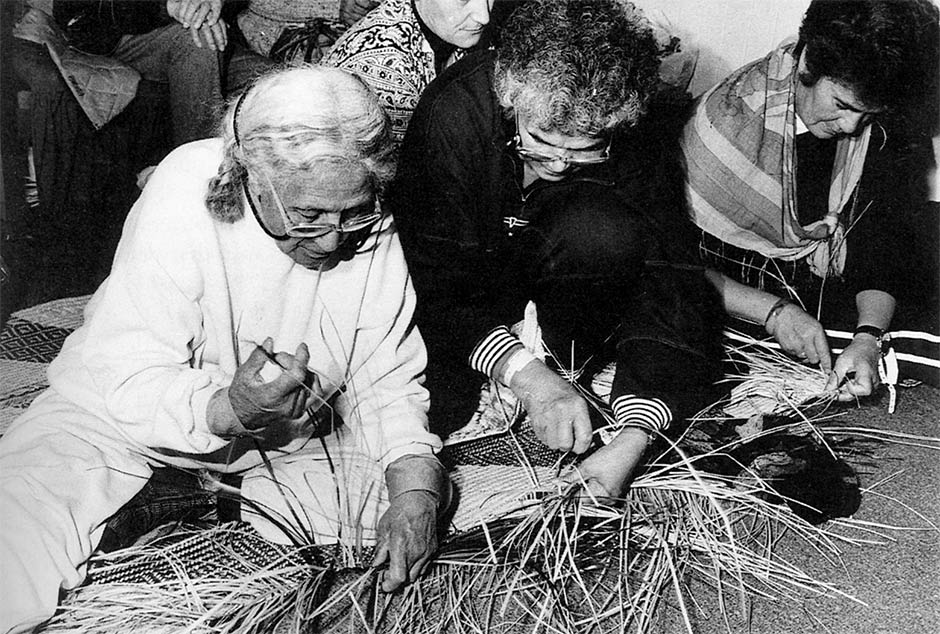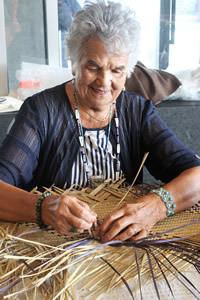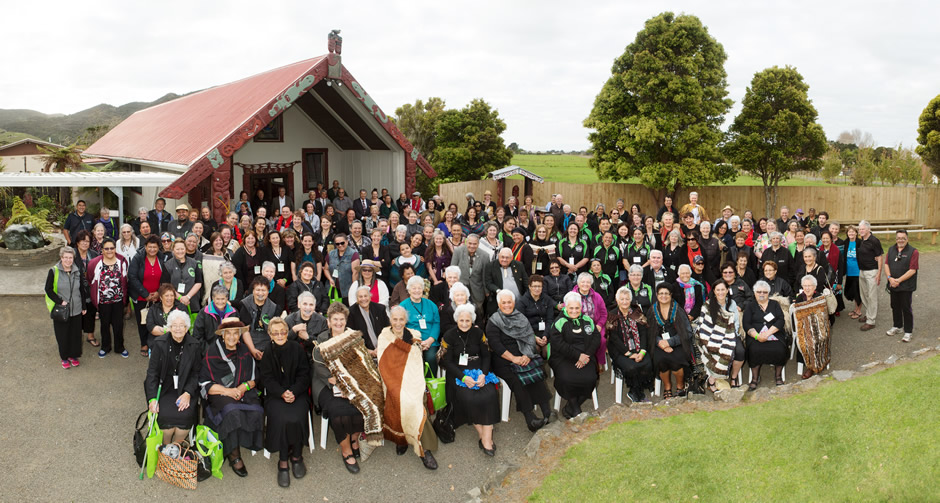
Te Roopu Raranga Whatu o Aotearoa
1983 –
Theme: Māori
Known as:
- Aotearoa Moana Nui A Kiwa Weavers
1983 – 1994 - Te Roopu Raranga Whatu o Aotearoa
1994 –
This essay written by Catherine Brown was first published in Women Together: a History of Women's Organisations in New Zealand in 1993. It was updated by Tracey Morgan in 2019.
In 1983, the Māori and Pacific Island Arts Council (MASPAC) invited a group of ten women [1] to look at the needs of weavers in Aotearoa and to come up with some ideas for fulfilling these. This group, which met for the first time at Rotorua in April 1983, was to form the weavers' committee of MASPAC, taking the name Aotearoa Moana Nui A Kiwa Weavers in 1986. Their kaupapa was to nurture, foster and preserve the techniques and the love of weaving with and for our people.
Those present became a steering committee, making Emily Schuster the convener. They decided unanimously to gather weavers to discuss their needs at a Labour Weekend hui, which Ngoi Pēwhairangi offered to host at Tokomaru Bay. MASPAC funds enabled weavers from around the country to attend; 160 were planned for, and more than 400 came. The steering committee drew up a programme involving presentations, talk sessions and seminars. The assembled weavers co-operated, but were really more interested in getting their hands around some harakeke; Pasifika weavers brought pandanus, and spent long hours finishing a mat for the marae. Work brought by the women was exhibited in an empty shop nearby, and Sandy Adsett designed a hui logo, which was later adopted by the new group. Te Arikinui, Dame Te Atairangikaahu, attended the hui, as did Sir Kingi Īhaka, chairman of MASPAC, to offer support and encouragement.
The weavers asked for an organisation to co-ordinate and care for the interests of Māori and Pasifika weavers. They requested another hui the following year, where they could work together to share techniques and skills. They did not want too many talk sessions – the talking happened quite naturally in the work groups, and their hands were their voices. They also wanted priority given to conservation of materials, and Rene Orchiston spoke about her collection of harakeke. Over the following year, it was found that many local authorities were already planting flax for use by local weavers.
Six hundred people came to the 1984 hui at Te Teko, and a larger exhibition was set up in the dining room. Pasifika groups were asked to bring materials from their homelands for demonstrations and workshops. Dr Warwick Harris came as an invited representative of the Department of Scientific and Industrial Research, beginning a fruitful relationship between the weavers and the Botany Division at Lincoln College (later Lincoln University). The weavers raised testing questions about the re-establishment of plants to provide materials, and as a result Dr Harris embarked on propagating Rene Orchiston's collection at Lincoln. Many weavers took advantage of the flax plants available to them, and the collection became the basis of planting throughout both islands.

Gil Hanly photo / Aotearoa Moana Nui A Kiwa Weavers / Te Waka Toi
Rūhia Oketopa, Mate Lawless and Tina Wirihana at Ngā Puna Waihanga hui at Ōmaka marae, June 1992.
The group continued to take a major interest in plant conservation and continuity of supply. Jenny Oliphant gave out pīngao plants at the Ngāruawāhia hui in 1985, and some had great success with them. Committee members became involved with several replanting projects. Dr Harris set out to find some of the plants loved and required by Pasifika groups; he provided paper mulberry plants for tapa cloth, and by 1993 was working on finding pandanus suitable for growing in Auckland and Northland. In 1988 an International Ethno-Botany Conference was co-hosted by the weavers and the DSIR at Rehua marae, Christchurch, and a ceremonial planting of harakeke and paper mulberry took place at Lincoln.
The group's first national exhibition, 'Te Pūawaitanga', consisting mainly of traditional work from Māori and Pasifika weavers, began in Christchurch in March 1987, when 'Te Māori' returned from the USA; it then travelled to Rotorua and Auckland, looked after by Tui Ransfield. This exhibition opened the eyes of many people, not least weavers themselves, who suddenly saw their work in a different light. The second, held in 1989–90 at the Bathhouse Gallery in Rotorua, included many contemporary pieces and showed new directions for weaving.
Regional exhibitions became regular events in some areas: for 1987 on, Mata Smith was responsible for Niue weavers in Auckland mounting an annual November show, Cath Brown put together a touring show for the top of Te Waipounamu, Rānui Ngārimu and Tai Poutini Weavers exhibited at Greymouth, and Toi Maihi co-curated a show in Auckland. Several others were being planned in 1993.
Not all of the group's exhibition efforts were successful. Several attempts to go into partnership with other agencies, in order to train a sensitive curator, resulted only in frustration. By 1993 Kura Te Waru Rēwiri had been contracted to curate two exhibitions in conjunction with the 1993 Symposium of Weavers from the Pacific Rim: a traditional Māori exhibition, and works brought by those attending.
The group contributed work for the exhibition 'Amokura', which travelled to the UK and Europe in 1986; weavers Diggeress Te Kanawa and Aromea Te Maipi travelled and worked with it in England and Scotland. The weavers were also happy to support exhibitions mounted by Te Waka Toi. [2] The latest of these, 'Te Waka Toi', began its tour in San Diego in 1992, with Te Auē Davis, Tina Wirihana, Cath Brown and Diggeress Te Kanawa working alongside it. Lydia Smith accompanied it to Arizona; in 1993 it moved on to Seattle and Hawaii. The group's weavers supported the South Pacific Arts Festivals held in Townsville and Rarotonga, and members were included in the official delegations.
The first visitors from overseas were two Niue women who came in 1985. Pearl Sunrise, a Navajo weaver from New Mexico, arrived in 1986. A steady stream of overseas weavers were helped by Emily Schuster at the Māori Arts and Crafts Institute in Rotorua, and by Diggeress Te Kanawa at Ōhākī Village. Groups of Aotearoa weavers saved to travel to Tonga in 1990 and to the Cook Islands in 1992, so as to exchange knowledge and learn about techniques and processes used there. Early in 1992, Tongan weavers were hosted at the Papakura hui.
The group took an interest in relevant research. In 1993 constant requests for muka came from Dr Peter Barber, who with his research students at Otago University was examining the strength of the flax fibre and looking at effective dyes. The group co-funded the training of Rangi Warnes (formerly Te Kanawa) as a museum conservator of textiles; in 1993 Vicki Heykell was also completing her training. Weavers were looking forward to seeing the influence these two young women would have with regard to textiles here.
From the time the group began, a photographic record was kept. The group also owned several video recordings of individuals and their work, and events at hui. Emily Schuster and Diggeress Te Kanawa videoed kakahu and raranga in England, Scotland and the USA. An important event came in 1992, when Weaving a Kākahu, by Diggeress Te Kanawa, was co-published by the group and Bridget Williams Books.
Committee membership altered a little over the group’s first ten years. The first secretary, Karen Wattereus of MASPAC, was followed by Maria Amo Amo and Ngāire Deans. In 1993 Emily Schuster remained convener, with a committee of nine – six Māori and three Pasifika women – including original members Cath Brown, Waana Davis and Toi Maihi. Diggeress Te Kanawa, despite ill-health, was persuaded to continue making her valuable contribution; also on the committee were Te Auē Davis, Rānui Ngārimu, Mata Smith (Niue), Tepaeru Tereora (Cook Islands), and Emma Kesha (Samoa).
The newsletter, begun in 1984, with usually three issues a year by the 1990s, aimed to keep members up to date; but the main way of keeping in touch was through hui. The national hui was held biennially at Labour Weekend. Regional hui were organised locally, though committee members tried to attend and were often requested as tutors. In 1989, the Craft Panel of the Queen Elizabeth II Arts Council gave financial assistance for two special hui. The first, at Rapahoe, north of Greymouth, was for invited members who were experts in their field, but were often so occupied with teaching others that they had little chance to sit and work with their peers. The second, held at Waiariki Polytechnic in Rotorua, focused on contemporary weaving and gave weavers the chance to try out things they may have been a little scared to attempt before.
Without the solid support of Te Waka Toi, much that had been accomplished by 1993 would have been impossible. The 1993 rewriting of the Queen Elizabeth II Arts Council of New Zealand Act 1974 was expected to bring changes to which the committee, like its parent body, would adjust, because there was much more to be achieved for the weavers of Aotearoa.
Catherine Brown
1994–2019
The years from 1994 to 1996 were a period of tremendous growth for Māori arts within Aotearoa. The new Arts Council of New Zealand Toi Aotearoa Act 1994 established the Arts Council of New Zealand Toi Aotearoa, Te Waka Toi Māori Arts Board, and Pacific Arts Committee. Earlier, the Māori and South Pacific Arts Council (MASPAC) had seen an opportunity to use government funding to support the direct input of artists to government policies, and with these changes in structure, the Māori and Pacific weavers separated. In 1994, from Aotearoa Moana Nui a Kiwa emerged Te Roopu Raranga Whatu o Aotearoa (TRRWOA).
Whaea Matekino Lawless

Whaea Matekino Lawless weaves her kete at Maori ART Market 2017, Te Wharewaka, Wellington. Based in Rotoiti, Matekino has been weaving for over seventy years and continues to weave daily. She was a founding member of Te Kāhui Whiritoi, established in 2006 to recognise individuals who have contributed at a national level to the retention and promotion of Māori weaving arts. Examples of her work, chosen from a comprehensive collection of kākahu, whāriki and kete created since the 1980s, were shown in the exhibition Whatu Manawa: Celebrating the Weaving of Matekino Lawless, held at Tauranga Museum from December 2018 to March 2019.
Not only was the first Māori weavers’ national collective being formed, and named by renowned weaver Diggeress Te Kanawa, but a new charitable trust, Toi Maori Aotearoa, was also emerging. TRRWOA resolved to sit under the umbrella of Toi Maori Aotearoa as the weaving artform committee.
With the introduction of weaving qualifications in schools, private training organisations, wananga and universities throughout Aotearoa, Māori weaving saw a surge in people enrolling to learn the many skills that make up Te Whare Pora (the house of weaving). This increase of weavers nationwide would confirm that Māori weaving was alive and well.
In 2004, the first major International touring exhibition of Māori weaving, Toi Māori – The Eternal Thread, Te Aho Mutunga Kore, opened at Pataka Museum of Arts and Culture in Porirua. This exhibition demonstrated the spiritual significance of weaving within Māori culture, and featured traditional and contemporary work by more than forty leading Māori weavers. It travelled to Rotorua and Auckland, then on to Seattle, Salem and Warm Springs in North America, where it was viewed by over 50,000 people. The homecoming show held at Christchurch Art Gallery Te Puna o Waiwhetu in 2007 attracted 81,000 visitors.
TRRWOA continued to promote weavers and weaving nationally and internationally through exhibitions, workshops, art exchanges, residencies, and fashion shows. In addition, there were videos (of the National Weavers’ Hui at Maraenui in 2007, and the International Weavers’ Indigenous Gathering at Rotorua in 2010; a documentary, Whiri Toi: Creation of Our Minds and Hands in Art, 2008 [3]; and two major publications. The Art of Māori Weaving – The Eternal Thread Te Aho Mutunga Kore (2006), a photographic survey including several of the works shown in Toi Māori: The Eternal Thread, traversed the concepts and values of traditional Māori weaving and innovative, contemporary weaving practice. [4]
In 2011 the first edition of Whatu Kākahu was published. This celebration of the science and art of Māori weaving focused on the largest collection of Māori cloaks in the world at Te Papa Tongarewa, Wellington; it was relaunched in a revised edition in August 2019. [5] The second TRRWOA members’ exhibition opened at Waikato Museum, Hamilton, in 2019.
In 2019 the TRRWOA committee included an elected board of six Māori members, each sitting for a term of four years. The membership maintains ownership of TRRWOA and influences how the collective is directed. TRRWOA understands the importance of supporting weaving and regional weaving rōpū. The collective does this in several ways, such as endorsing members’ applications for research and research funding and attending regional wānanga/workshops as requested by members.
In partnership with the New Zealand Māori Arts and Crafts Institute, TRRWOA acknowledges dedication to weaving with a biennial Kahui Whiri Toi celebration. This group of senior practitioners provides informed knowledge and leadership and contributes in an advisory capacity to the committee.
From 1983 on, the biennial national weavers’ gatherings, hosted by weaving rōpū throughout Aotearoa, continued to be one of the key membership events, attracting weavers throughout the country and abroad. The size, scope and success of the national hui are a tribute to the host rōpū, their sponsors, whanau, hapū, iwi and community weavers.

Norman Heke, courtesy of Toi Maori Aotearoa
Weavers attending Ahipara Weavers Hui, Roma Marae, 2015.
In 2019 TRRWOA members were spread throughout the country, forming part of an international network of weavers conveying a strong and articulate voice for indigenous weaving. Many initiatives have been pioneered over the years, resulting in consolidated relationships, contributing to the successes of the TRRWOA national Māori weaving collective, and validating its purpose.
Tracey Morgan [6]
Notes
[1] The group consisted of the women members of MASPAC (except Waana Davis, who was unable to attend) and invited others.
[2] Te Waka Toi replaced MASPAC in 1990.
[3] Whiri Toi: Creation of Our Minds and Hands in Art, DVD, 45 mins, directed, produced and edited by Lala Rolls, Island Productions, Toi Maori Aotearoa, Te Roopu Raranga Whatu o Aotearoa, Creative New Zealand, Wellington, 2008. Covers the 2007 Māori weavers’ national hui held at Maraenui Marae in the Eastern Bay of Plenty, 2007.
[4] Evans, Miriama and Ranui Ngarimu, The Art of Māori Weaving: The Eternal Thread, Te Aho Mutunga Kore, Huia Publishers, Wellington, 2006.
[5] Awhina Tamarapa (ed.), Whatu Kākahu (2nd edn), Te Papa Press, Wellington, 2019.
[6] Editor, TRRWOA Newsletter (2015 – ).
Published sources
Aotearoa Moana Nui A Kiwa newsletters, 1983–1992
Te Awekotuku, Ngahuia, Mana Wāhine Māori, New Women’s Press, Auckland 1992, pp. 112–124
Further sources
Te Roopu Raranga Whatu o Aotearoa webpage:
https://www.Māoriart.org.nz/trrwoa.html
Hosts of Te Roopu Raranga Whatu o Aotearoa National Hui, 1983–2019
| 1983 | Pakirikiri Marae | Tokomaru Bay |
| 1985 | Kokohinau Marae | Te Teko |
| 1987 | Tunuhopu Marae | Rotorua |
| 1989 | Nga Mahi a Kui Ma | Greymouth |
| 1991 | Omaka Marae | Blenheim |
| 1993 | Parihaka Marae | Parihaka |
| 1995 | Te Reo Nihi Marae | Te Hāpua |
| 1997 | Takahanga Marae | Kaikōura |
| 1999 | Pakirikiri Marae | Tokomaru Bay |
| 2001 | Kokohinau Marae | Te Teko |
| 2003 | Te Rangimarie Marae | Palmerston North |
| 2005 | Ōwae Marae | Waitara |
| 2007 | Maraenui Marae | Maraenui |
| 2009 | Kahungungu Marae | Wairoa |
| 2011 | Maketu Marae | Kawhia |
| 2013 | Rautahi Marae | Kawerau |
| 2015 | Roma Marae | Ahipara |
| 2017 | Te Wai-iti Marae | Rotoiti |
| 2019 | Ngā Hāu e Wha Marae | Christchurch |

Community contributions